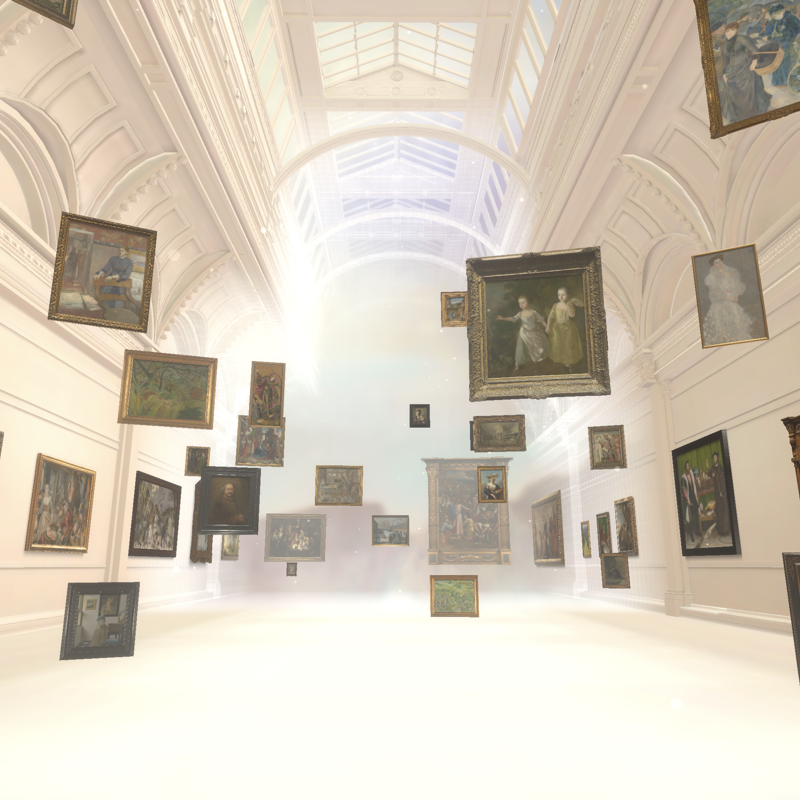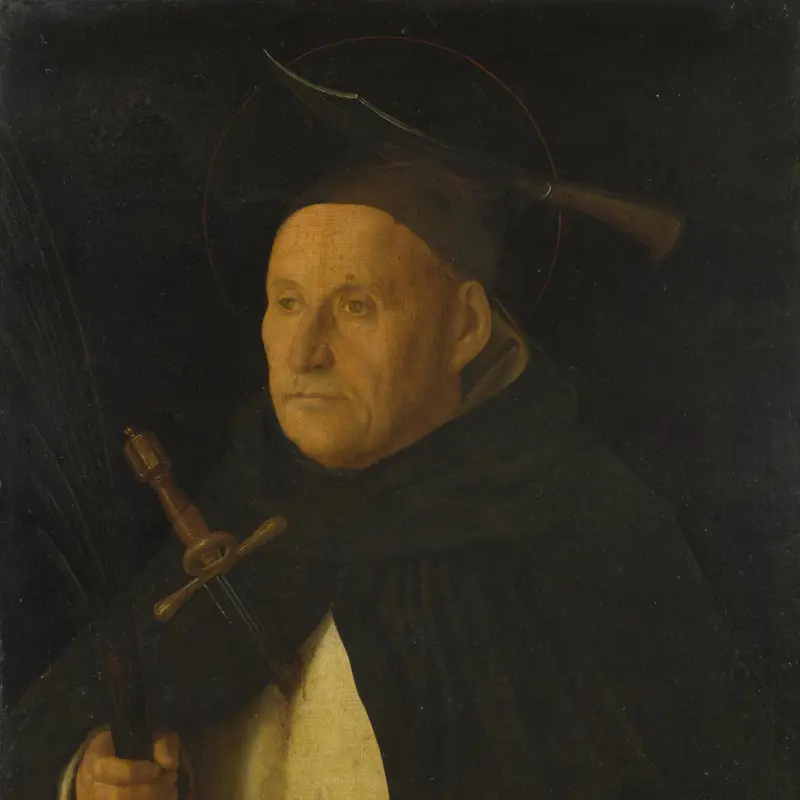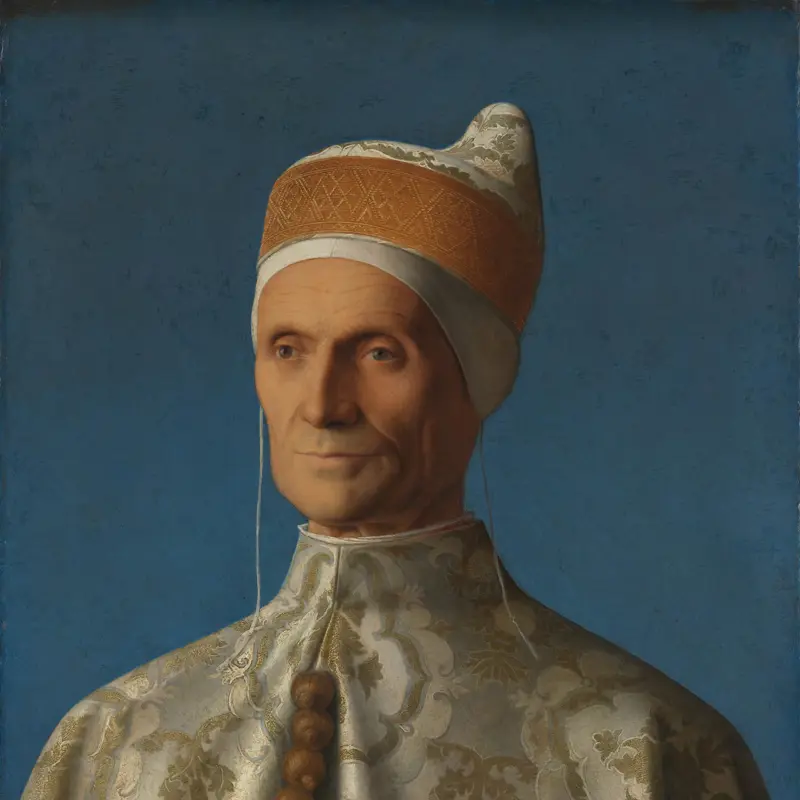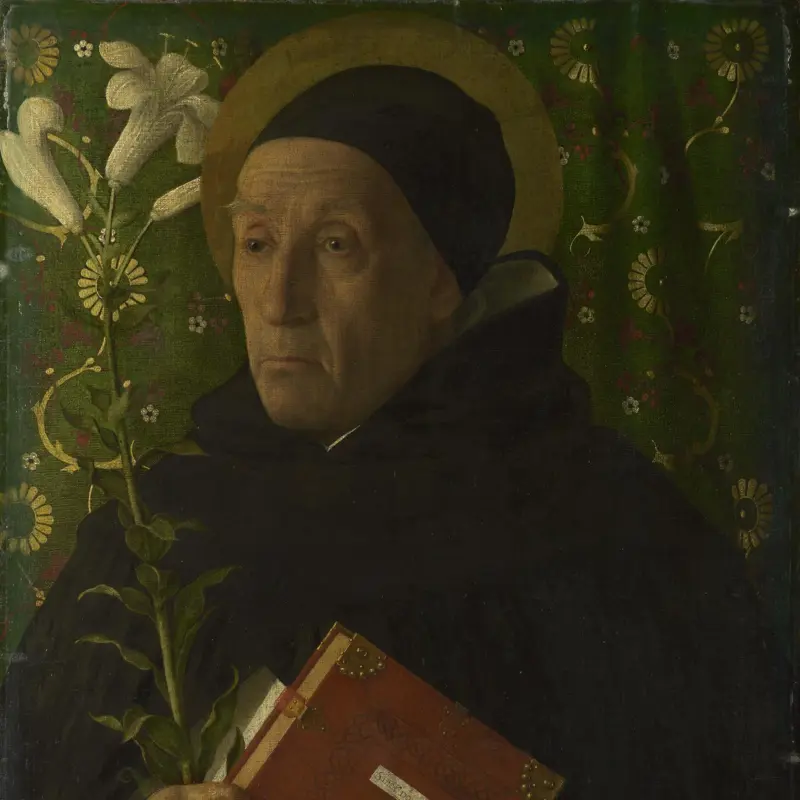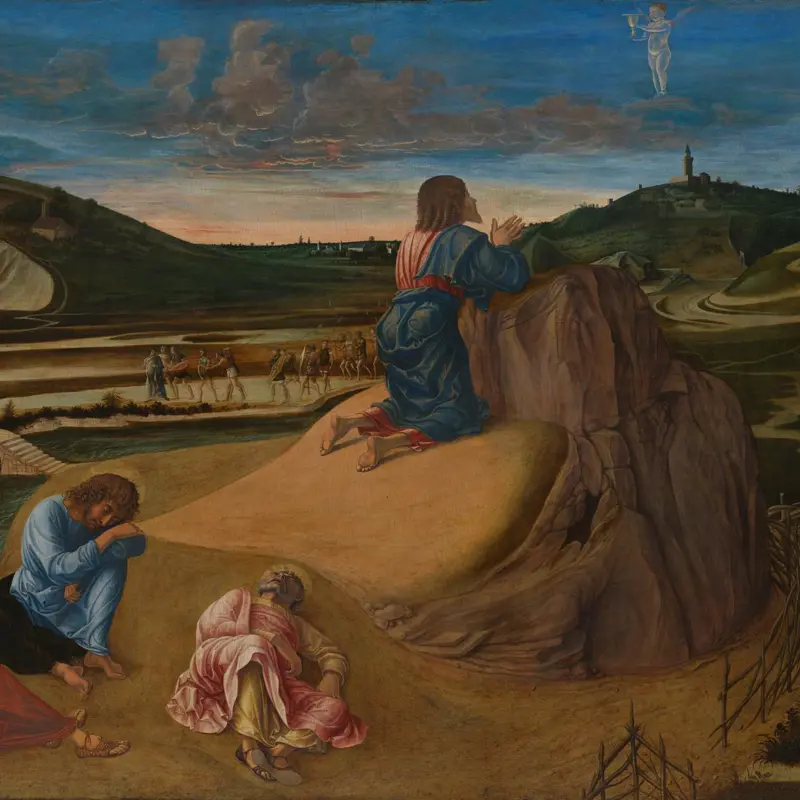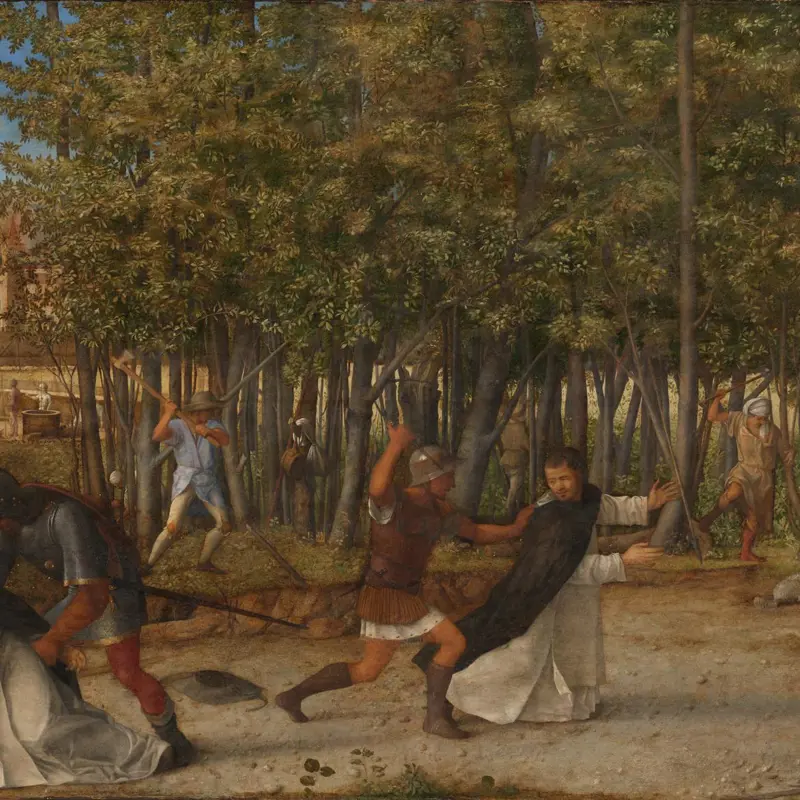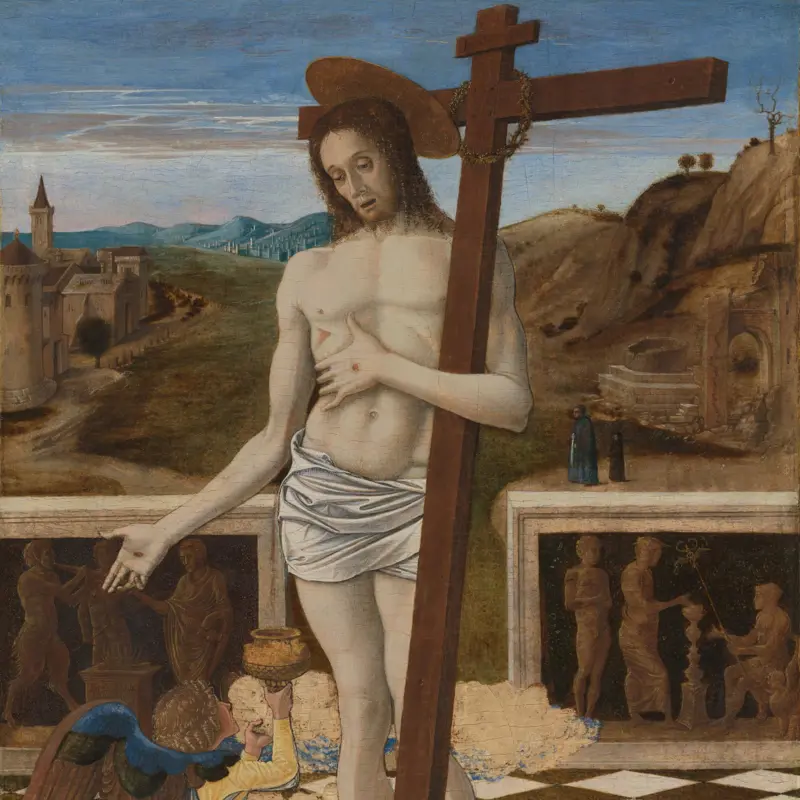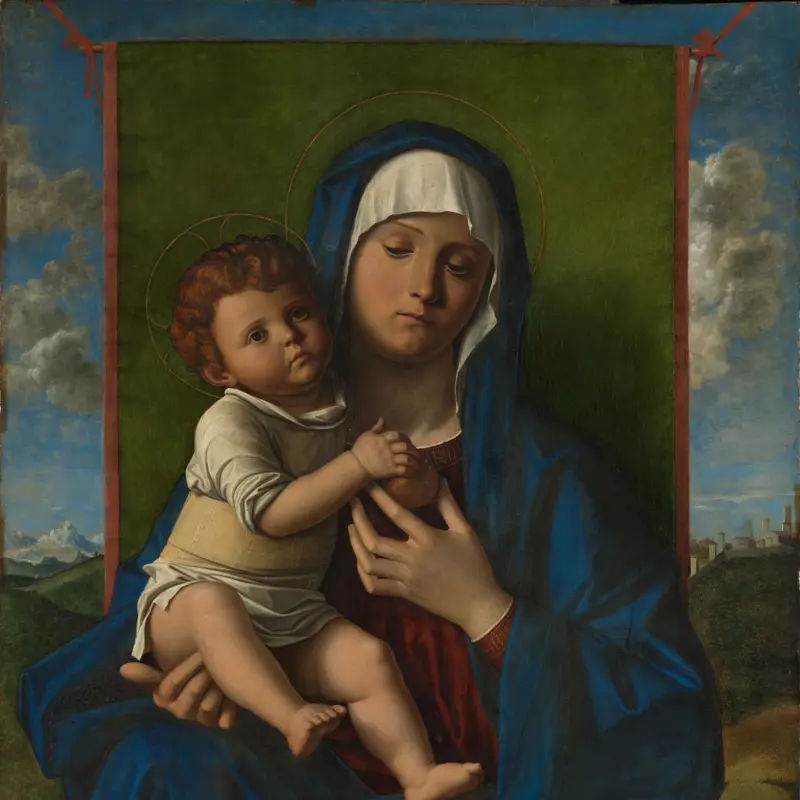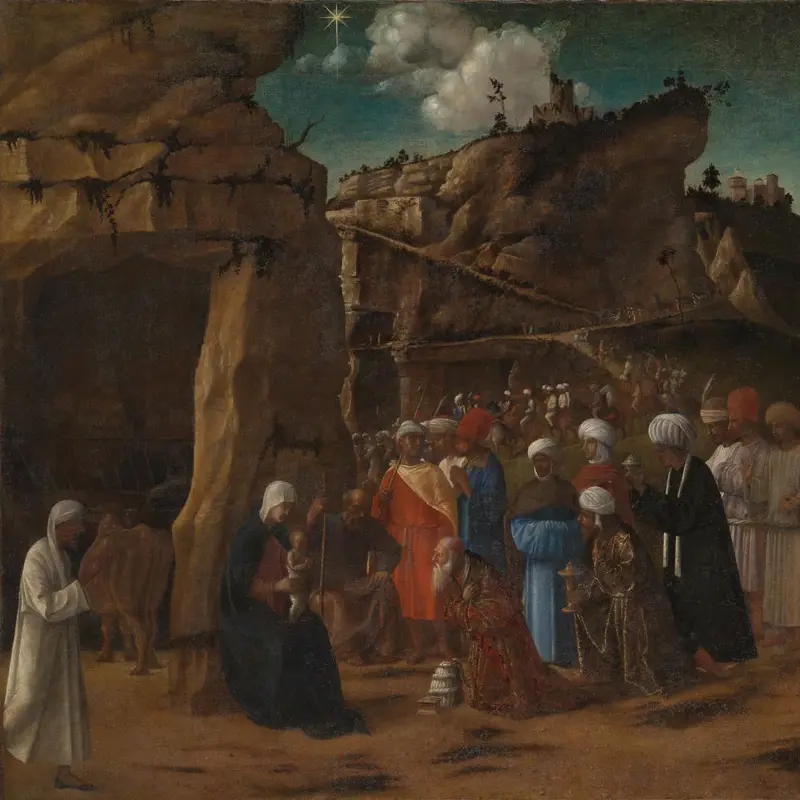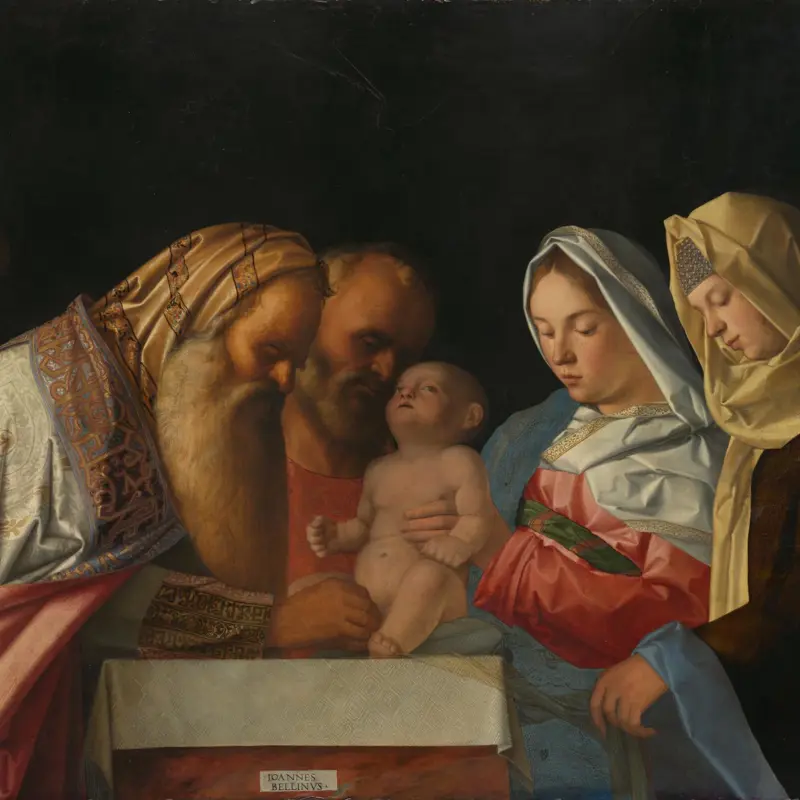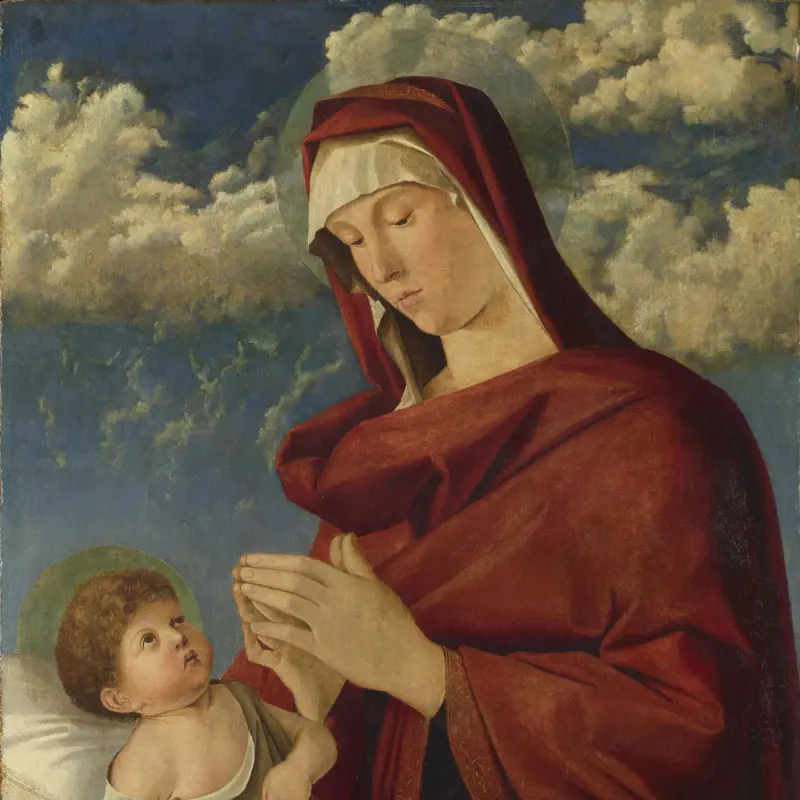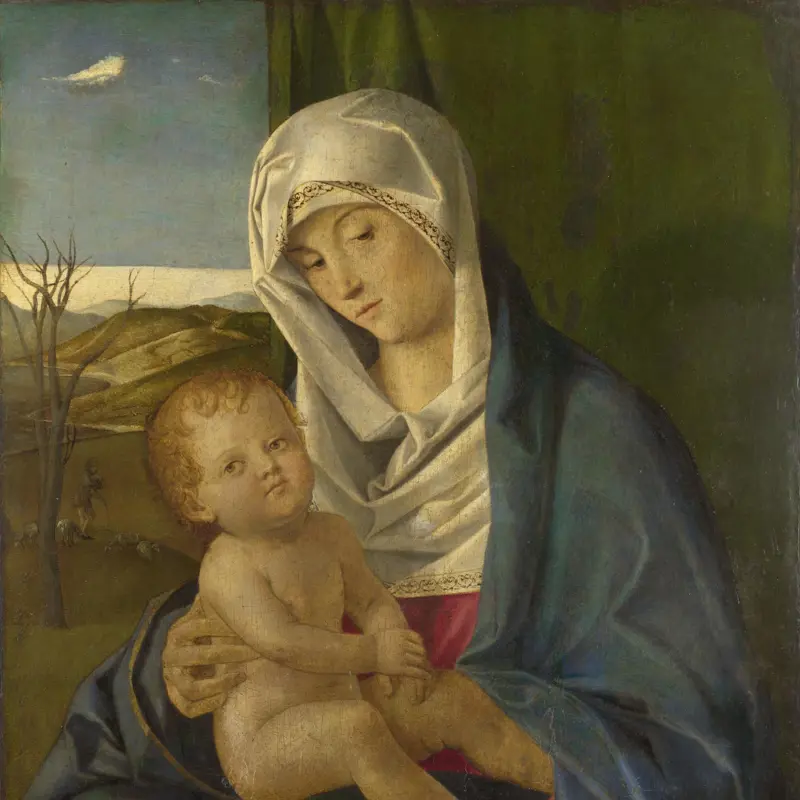Giovanni Bellini, 'Saint Jerome reading in a Landscape', about 1480-5
About the work
Overview
An elderly man, barefoot and with an impressive grey beard, is perched on a rock, engrossed in a book. This is Saint Jerome, translator of the Bible into Latin. His only companion is an endearing lion which lies peaceably in the corner – he had tamed it by removing a thorn from its paw.
Bellini painted this subject several times, always using landscape and dramatic lighting to convey meaning. Cliffs tower around Jerome, cutting him off from civilisation (represented by the walled city in the background). A bright light falls on the saint and on the distant towers, but the landscape between them is plunged in shadow.
Recent technical study has confirmed that the painting is by Bellini himself, rather than a follower. Jerome’s head is painted with great attention to detail, and if you look closely you can see the individual brushstrokes in his hair and beard.
Key facts
Details
- Full title
- Saint Jerome reading in a Landscape
- Artist
- Giovanni Bellini
- Artist dates
- about 1435 - 1516
- Date made
- about 1480-5
- Medium and support
- oil on wood
- Dimensions
- 46.8 × 33.8 cm
- Acquisition credit
- Bought, 1855
- Inventory number
- NG281
- Location
- Room 56
- Collection
- Main Collection
- Frame
- 16th-century Venetian Frame
Provenance
Additional information
Text extracted from the ‘Provenance’ section of the catalogue entry in Martin Davies, ‘National Gallery Catalogues: The Earlier Italian Schools’, London 1986; for further information, see the full catalogue entry.
Exhibition history
-
2008Giovanni BelliniScuderie del Quirinale30 September 2008 - 11 January 2009
-
2017Giovanni Bellini: Landscapes of Faith in Renaissance VeniceJ. Paul Getty Museum (Los Angeles)10 October 2017 - 14 January 2018
-
2018Mantegna and BelliniThe National Gallery (London)1 October 2018 - 27 January 2019
-
2023Venezia 500: The Gentle Revolution of Venetian PaintingAlte Pinakothek (Munich)27 October 2023 - 4 February 2024
Bibliography
-
1856R.N. Wornum, Descriptive and Historical Catalogue of the Pictures in the National Gallery With Biographical Notes of the Painters, 16th edn, London 1856
-
1856London, National Gallery Archive, dossier for NG 280: Report of the Director of the National Gallery to the Lords Commissioners of Her Majesty's Treasury, 5 March 1856
-
1857G.F. Waagen, Treasures of Art in Great Britain: Being and Account of the Chief Collections of Paintings, Drawings, Sculptures, Illuminated Mss. […], translated from German by Elizabeth Eastlake, 3 vols, London 1857, vol. 3
-
1867A.A. Lavice, Revue des musées d'Angleterre, Paris 1867
-
1871J.A. Crowe and G.B. Cavalcaselle, A History of Painting in North Italy: Venice, Padua, Vicenza, Verona, Ferrara, Milan, Friuli, Brescia, from the Fourteenth to the Sixteenth Century, 2 vols, London 1871
-
1878H. Blackburn, Illustrated Catalogue to the National Gallery: Foreign Schools, London 1878
-
1887W. Armstrong, 'Notes on the National Gallery', The Guardian, 1887
-
1888E.T. Cook, A Popular Handbook to the National Gallery Including, by Special Permission, Notes Collected from the Works of Mr. Ruskin, London 1888
-
1923R. van Marle, The Development of the Italian Schools of Painting, 19 vols, The Hague 1923
-
1929National Gallery, National Gallery, Trafalgar Square: Catalogue, 86th edn, London 1929
-
1930G. Gronau, Giovanni Bellini, Stuttgart 1930
-
1932B. Berenson, Italian Pictures of the Renaissance: A List of the Principal Artists and Their Works, with an Index of Places, Oxford 1932
-
1937C. Gamba, Giovanni Bellini, Milan 1937
-
1949L. Düssler, Giovanni Bellini, Vienna 1949
-
1951Davies, Martin, National Gallery Catalogues: The Earlier Italian Schools, London 1951
-
1951R. Pallucchini, 'Cataloghi', Arte veneta, V/17-20, 1951, pp. 194-7
-
1957B. Berenson, Italian Pictures of the Renaissance: A List of the Principal Artists and Their Works, with an Index of Places: Venetian School, 2 vols, London 1957
-
1961M. Davies, The Earlier Italian Schools, 2nd edn, London 1961
-
1962F. Heinemann, Giovanni Bellini e i Belliniani, 3 vols, Venice 1962
-
1962E. Arslan, 'Studi belliniani', Bollettino d'arte, XLVII/4, 1962, pp. 40-58
-
1963S. Bottari, Tutta la pittura di Giovanni Bellini, Milan 1963
-
1968G. Robertson, Giovanni Bellini, Oxford 1968
-
1969T. Pignatti, L'opera completa di Giovanni Bellini, Milan 1969
-
1972N. Huse, Studien zu Giovanni Bellini, Berlin 1972
-
1983B. Contardi and A. Gentili, Il San Girolamo di Lorenzo Lotto a Castel Sant'Angelo, (exh. cat. Castel San Angelo, 1983), Rome 1983
-
1985C.T. Dowd, 'The Travel Diary of Otto Mündler', The Walpole Society, LI, 1985
-
1986Davies, Martin, National Gallery Catalogues: The Earlier Italian Schools, revised edn, London 1986
-
1989R. Goffen, Giovanni Bellini, New Haven 1989
-
1992A. Tempestini, Giovanni Bellini. Catalogo completo dei dipinti, Florence 1992
-
1994R. Echols, 'Cima and the Theme of Saint Jerome in the Wilderness', Venezia cinquecento, IV/8, 1994, pp. 47-69
-
1995J. Paris, L'atelier Bellini, Paris 1995
-
1997A. Tempestini, Giovanni Bellini, Milan 1997
-
1999M. Heimbürger, Dürer e Venezia: Influssi di Albrecht Dürer sulla pittura veneziana del primo Cinquecento, Rome 1999
-
1999G. Berra, 'Immagini casuali, figure nascoste e natura antropomorfa nell'immaginario artistico rinascimentale', Mitteilungen des Kunsthistorischen Institutes in Florenz, XLIII/2-3, 1999, pp. 358-419
-
2001
C. Baker and T. Henry, The National Gallery: Complete Illustrated Catalogue, London 2001
-
2001U. Soragni and L. Francioni, 'Soave e Cattaro, città "Catara": Le pale di Murano e di Pesaro di Giovanni Bellini', Studi giorgioneschi, V-VI, 2001, pp. 7-34
-
2003I. Alexander-Skipnes, 'Saint Jerome in the Wilderness: Paintings in Venice by Piero della Francesca, Giovanni Bellini and Hieronymus Bosch', in H. Verougstraete-Marcq and R. van Schoute (eds), Jérôme Bosch et son entourage et autres études, Louvain 2003, pp. 286-97
-
2008M. Lucco and G.C.F. Villa, Giovanni Bellini, (exh. cat. Scuderie del Quirinale, 30 September 2008 - 11 January 2009), Milan 2008
-
2008M. Lucco and G.C.F. Villa (eds.), Giovanni Bellini (exh. cat., Scuderie Papali al Quirinale, Rome), Milan 2008
About this record
If you know more about this work or have spotted an error, please contact us. Please note that exhibition histories are listed from 2009 onwards. Bibliographies may not be complete; more comprehensive information is available in the National Gallery Library.

